Gerard Gierlinski's trip to the Greek island of Crete in 2002 was meant to be a romantic getaway for him and his girlfriend. But it ended up becoming considerably more momentous than that - leading to a discovery that could dramatically alter the story of the human race.
It was Gierlinski's first time on the island, a popular holiday destination for Poles like himself. He and his partner, Beata Piechik, were there to walk the sandy beaches, swim in the Mediterranean Sea and enjoy food and wine in the quiet tourist village of Trachilos, which is dotted with small houses and a handful of hotels.
"It's an amazing, beautiful area," Gierlinski recalled. But being a paleontologist at the Polish Geological Institute, Gierlinski was also prepared to record any discoveries he might make.
"I always carry - even on vacation - a hammer, a camera and a GPS," he said.
So when he spotted an odd imprint in a rock along the beach, he was ready.
Gierlinski has studied dinosaur tracks and recognized the indentation as a footprint. And there were others. It was around noon, and the sunlight was too harsh to enable him to see the full details of the impressions - but he could immediately tell that they weren't dinosaur tracks. He took a number of photographs of the imprints (including one with Piechik sitting on the rock). And, crucially, he captured the GPS co-ordinates, so he could find the place again.
They eventually headed back home from their idyllic holiday, but Gierlinski couldn't get those prints out of his head. For eight years, he wondered about them. In 2010, he found a good deal on an all-inclusive package and went back to Crete - and felt compelled to return to that spot. (By this time, he had broken up with Piechik.)
It was almost evening when he revisited that flat slab on the beach, one that tourists often sit on as they drink and gaze out at the sea. This time, the long shadows clearly revealed the outline of the footprints - prints that clearly resembled the shape of his own foot.
"This was like a shock for me," Gierlinski said.
He eventually brought in other experts from Poland, as well as from Sweden, Greece, the U.S. and England, to help him analyze the footprints and the sediments surrounding them. Together, they determined the tracks were left by ancient human relatives 5.6 million years ago. That would make them the oldest human-like footprints in the world - two million years older, in fact, than the oldest found in Africa, long considered the "cradle of humankind."
Gierlinski said it could suggest an unexpected and untold part of the story of where humans came from. "It's a new frontier in the study of our ancestors," he said.
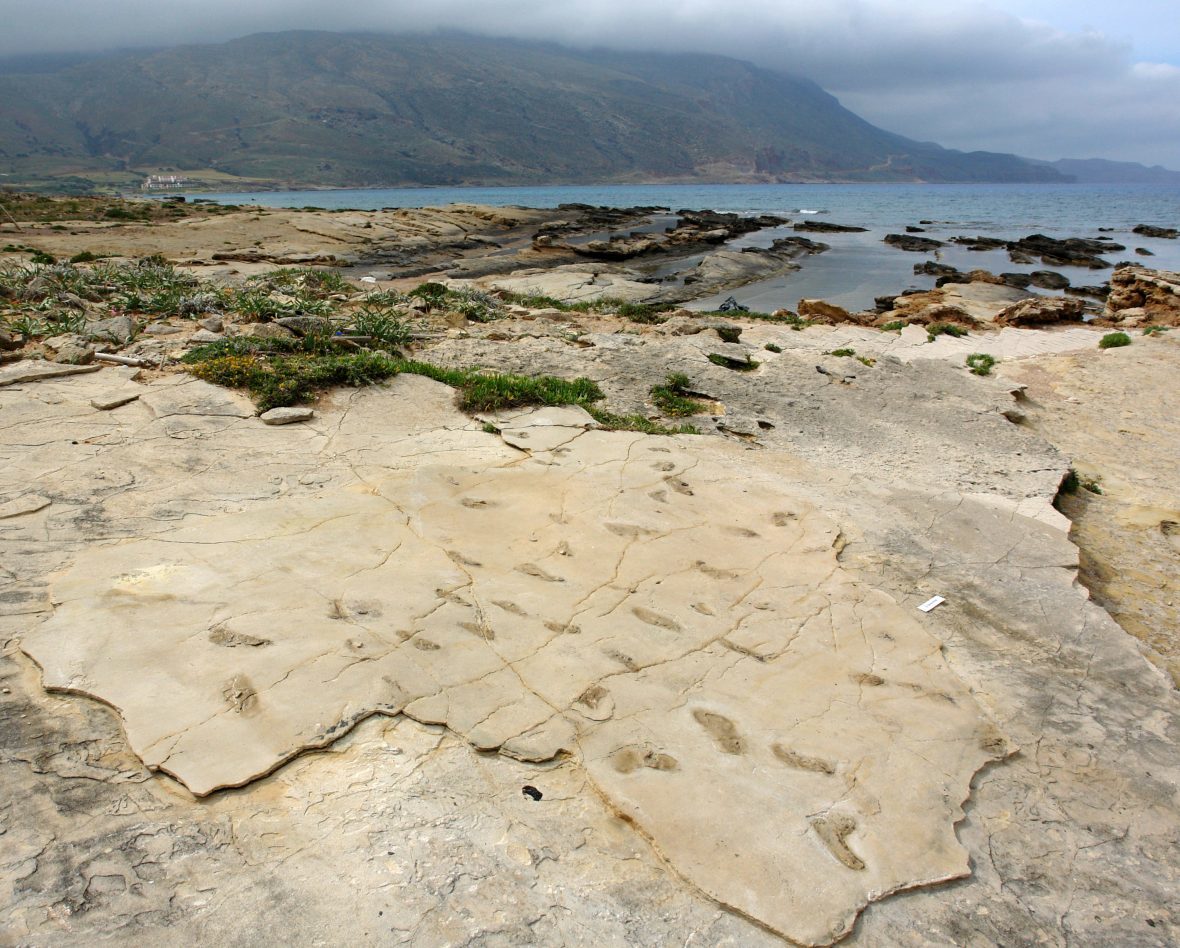
No pre-human fossils that old have ever been found in Europe, and Gierlinski's claim generated vicious criticism and disbelief from other scientists in a field where most influential researchers are committed "Africanists."
Per Ahlberg, a researcher at Uppsala University in Sweden, was the member of Gierlinski's team who took responsibility for getting the research published, and described the process as "six and a half years of sort of living hell."
Gierlinski's find casts a light not only on the often chance nature of scientific discovery, but the sometimes fierce conflict among the humans in the scientific community, who often bristle when their beliefs are challenged by new ideas - especially ones that may be ahead of their time.
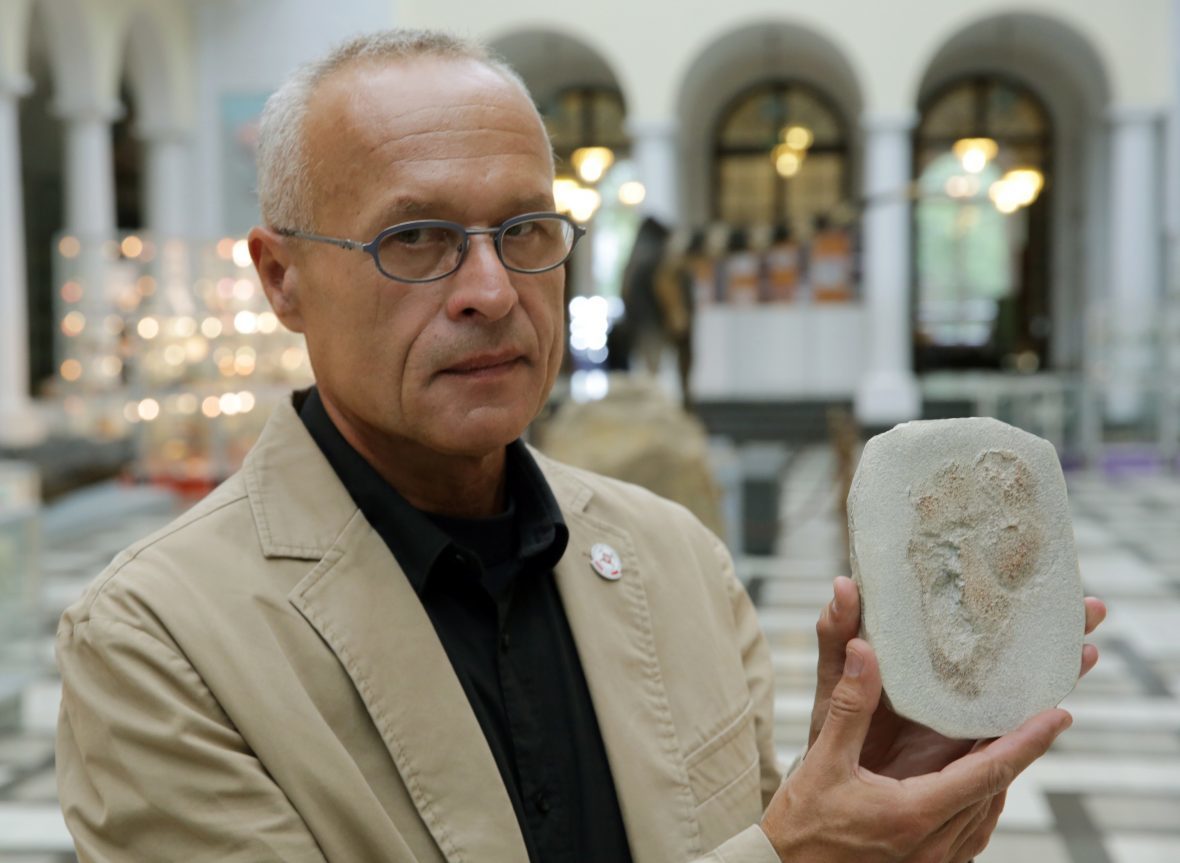
Gierlinski is no stranger to astonishing discoveries. In the past, he found the feather imprints from a dinosaur's belly that had rested on the mud millions of years ago in Massachusetts. He was also one of the co-authors of a study of footprints that suggested dinosaurs "danced" to attract mates, in much the same way some modern birds do. Those discoveries piqued people's interest, but didn't cause much controversy.
But when Gierlinski saw the Trachilos footprints for the second time and recognized their human-like shape, he realized that he had found something extraordinary.
After returning to Poland, he looked up the age of the sediments in Trachilos and was amazed to learn they were from the Miocene era. In layers of rock and sediments, the start of the Miocene is marked by a deposit left when the Mediterranean Sea temporarily dried up about 5.6 million years ago.
That was before a group of human-like footprints were left in volcanic ash at Laetoli, Tanzania. The 3.66-million-year-old Laetoli footprints have long been regarded as the oldest human-like footprints in the world.
The Miocene also predates Ardipithecus, a fossil hominin with an ape-like foot that lived in modern-day Ethiopia 4.4 million years ago and is thought to be part of the human lineage.
After his second visit to Trachilos, Gierlinski felt he urgently needed to go back a third time to further study the prints, and he needed other experts to assure him that what he thought they were was true - in other words, that he wasn't crazy.
After a party in Warsaw several weeks after his second visit, Gierlinski showed pictures of the prints to two fellow researchers, Grzegorz Niedzwiedzki and Andrzej Boczarowski. He was going back to Crete in a few days - did they have time to come? They jumped at the chance.
When they arrived in Trachilos in November 2010 and began cleaning the surface of the slab of rock, they realized that it was embedded with not just one or two but dozens of fossil footprints - shallow impressions left in sand long ago that later hardened into rock.
Niedzwiedzki had recently started a postdoctoral fellowship with Ahlberg at Uppsala University and got him involved in the project. Ahlberg, in turn, suggested it would be a good idea to involve Greek researchers and the Greek Ministry of Heritage and Culture, and get permits before proceeding further.
Since the researchers initially involved in the project were experts in animal rather than human tracks, the team also got help from Matthew Bennett, a researcher at Bournemouth University in the U.K. who had studied the Laetoli footprints.
The Trachilos footprints are quite small, the largest no more than 23 centimetres long - roughly the size of a women's size six shoe. The team found that "in the front, the toes are very human-like," Gierlinski said. But the heel is narrower, like that of a chimpanzee or gorilla.
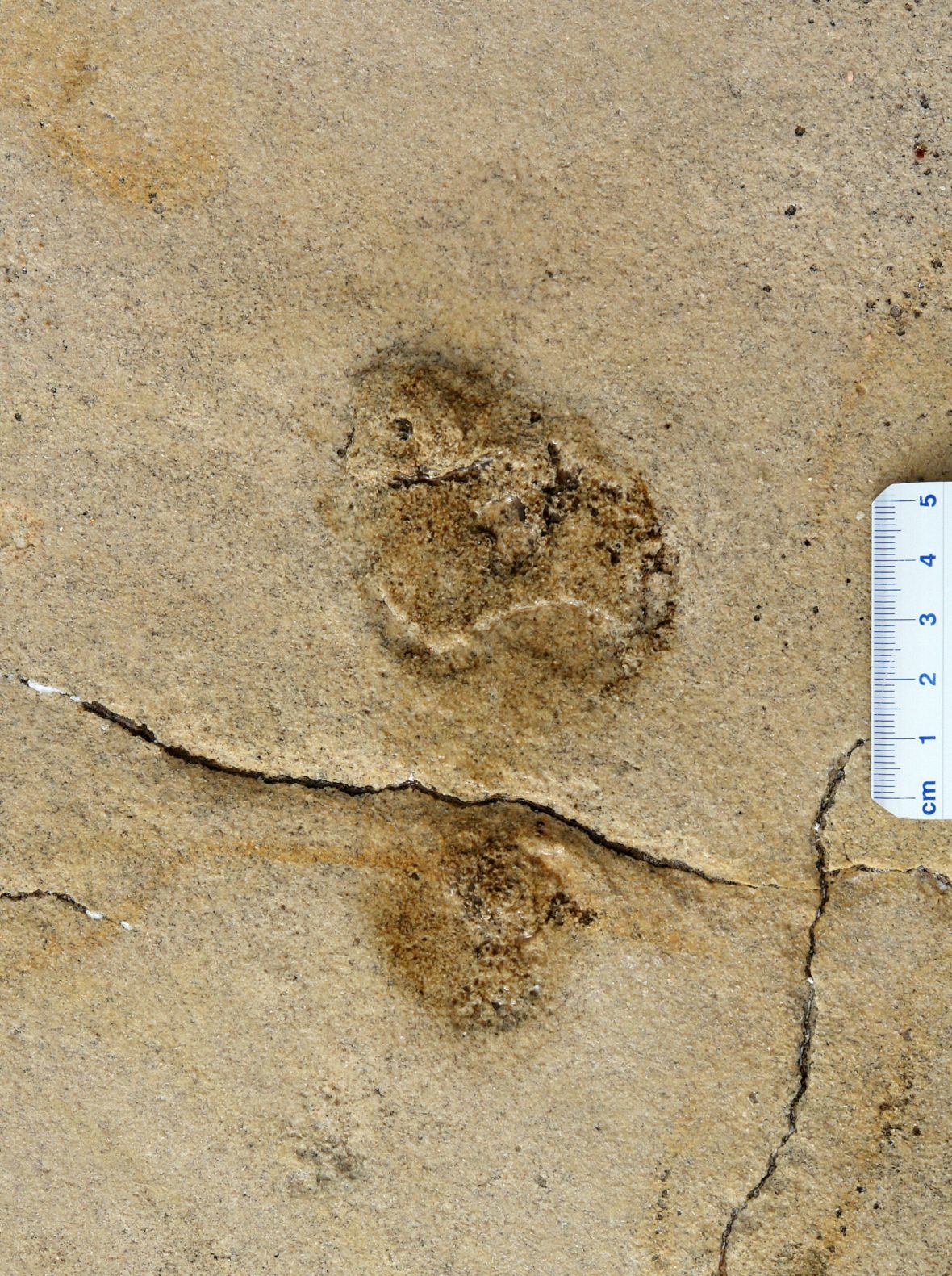
The prints clearly belonged to creatures that normally walked on two feet. They kept their feet close together, like humans, rather than waddling, as chimpanzees do.
"What's also very telling is we have no palm prints ... nor are there any knuckle prints," Ahlberg said.
He also noted that based on the orientation and placement of the tracks, the creatures didn't seem to be going anywhere in particular. "The impression you get subjectively is of a little troop of these guys just sort of hanging out, just doing their thing in that sort of vaguely disorganized way that a troop of chimpanzees might do."
The researchers think the creatures that made the prints could potentially be part of the human family tree. Or, they could potentially have been from another branch of upright-walking ape that happened to have developed similar feet - something they think is less likely.
Gierlinski said it was the most extraordinary find of his career. These are "the oldest human-like tracks in the world, unexpectedly found in Europe, not in Africa," he said. "Obviously, it's very important."
In 2011, the researchers were ready to share these exciting findings with the world. And that's when the trouble began.
III. 'Savagely hostile'
What happened next provides a window into the world of scientific publishing, where discoveries must run a gauntlet of all-too-human gatekeepers before becoming official and public.
The team started submitting the research to peer-reviewed journals. Since this appeared to be something extraordinary - the oldest human-like footprints in the world - they started with high-profile publications such as Nature.
Since the editors of scientific journals aren't experts on every topic, they typically send submitted manuscripts to expert peer reviewers to evaluate the quality of the research.
Many of the reactions to the Trachilos discovery were negative, to say the least. Ahlberg has been publishing papers since 1989 - including in Nature and Science - and had never experienced anything like this before.
"We got ferociously aggressive responses saying this couldn't possibly be true and these can't be footprints at all," said Ahlberg. "In every round [of reviews], there would be at least one, and sometimes several, reviewers who were in the first instance savagely hostile. They would just flatly deny that these would be human or hominin footprints. They would say almost anything - they're bear or monkey [tracks] or whatever."
Ahlberg shared some of the reviews with CBC, and they appeared to match his descriptions, but warned that they could not be reproduced for confidentiality reasons.
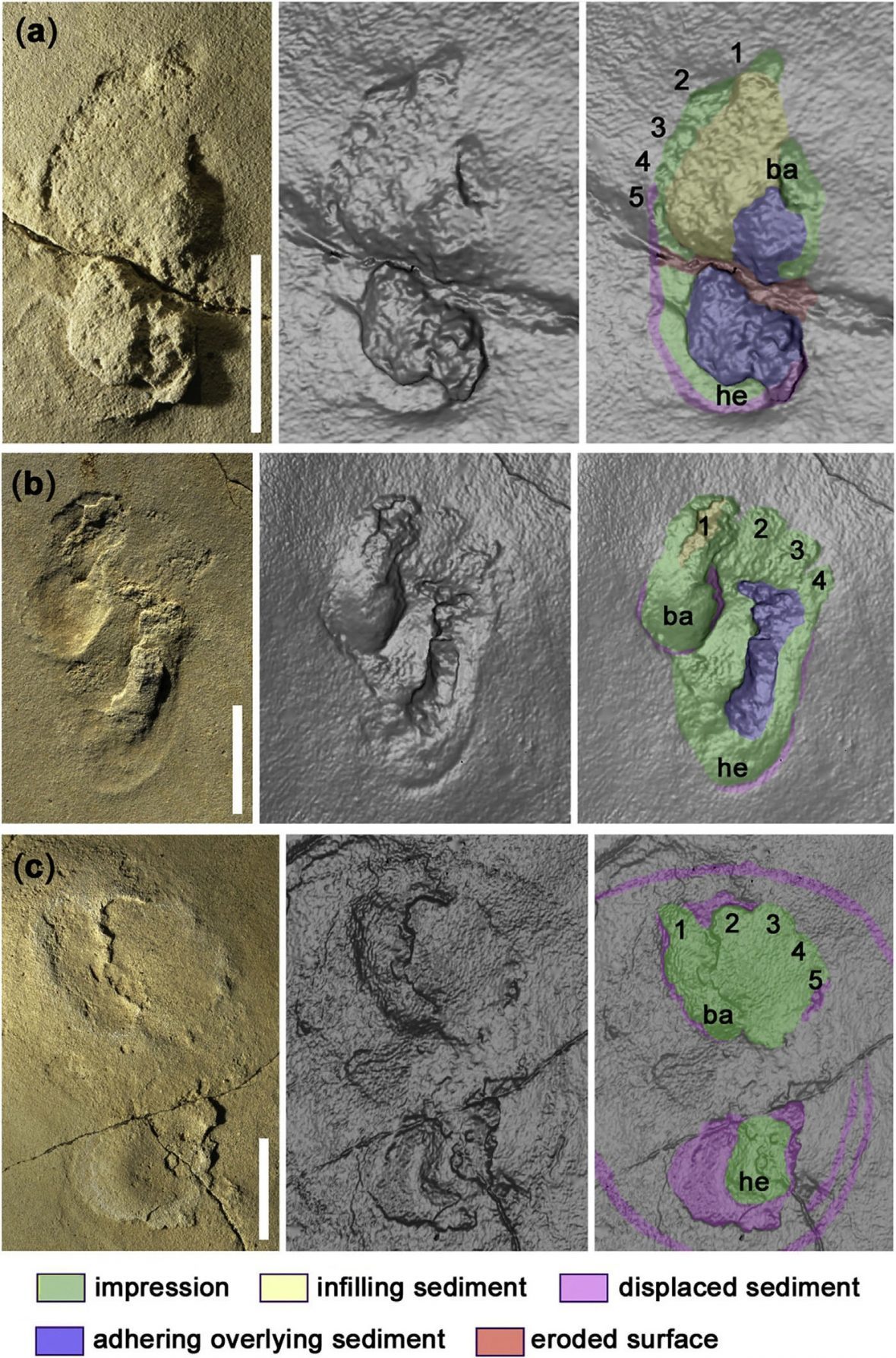
The researchers addressed any criticism they could with further measurements, but the rejection letters continued to pile up as the researchers moved from one journal to the next.
Ahlberg alleged many of the reviews accused the authors, who were mostly experts in ancient footprints, of incompetence in interpreting tracks. But the reviewers provided no evidence to support their criticisms.
"Basically, it wasn't a true peer review process at all," he said. "They were just trying to shut us down." One editor rejected the paper even though two out of three reviews were positive, which is unusual.
Gierlinski said he doesn't blame the reviewers, as he often reviews papers himself and "sometimes I am not so nice also." But he said he was frustrated with the journal editors who rejected the paper outright in response to the reviews, instead of giving the researchers the chance to make changes in response to the criticism.
Peer review is supposed to be a confidential process and researchers are not supposed to share unpublished work that they're reviewing. But Ahlberg said he and his colleagues "began to hear on the grapevine that the paleoanthropological community was abuzz about our work - work that had never been presented anywhere."
According to Ahlberg, one researcher Niedzwiedski encountered at an unrelated meeting told him he would never get his footprint work published.
Meanwhile, back at Trachilos, the subject of all this venom was in physical jeopardy. Local vandals had spray-painted the footprints with anti-war graffiti. Ahlberg doesn't think they were deliberately trying to the damage the footprints, which they probably didn't even know were there - they were just attracted by the smooth surface.
The researchers felt they needed to get their story out to the media in order to motivate Greek authorities to protect the site.
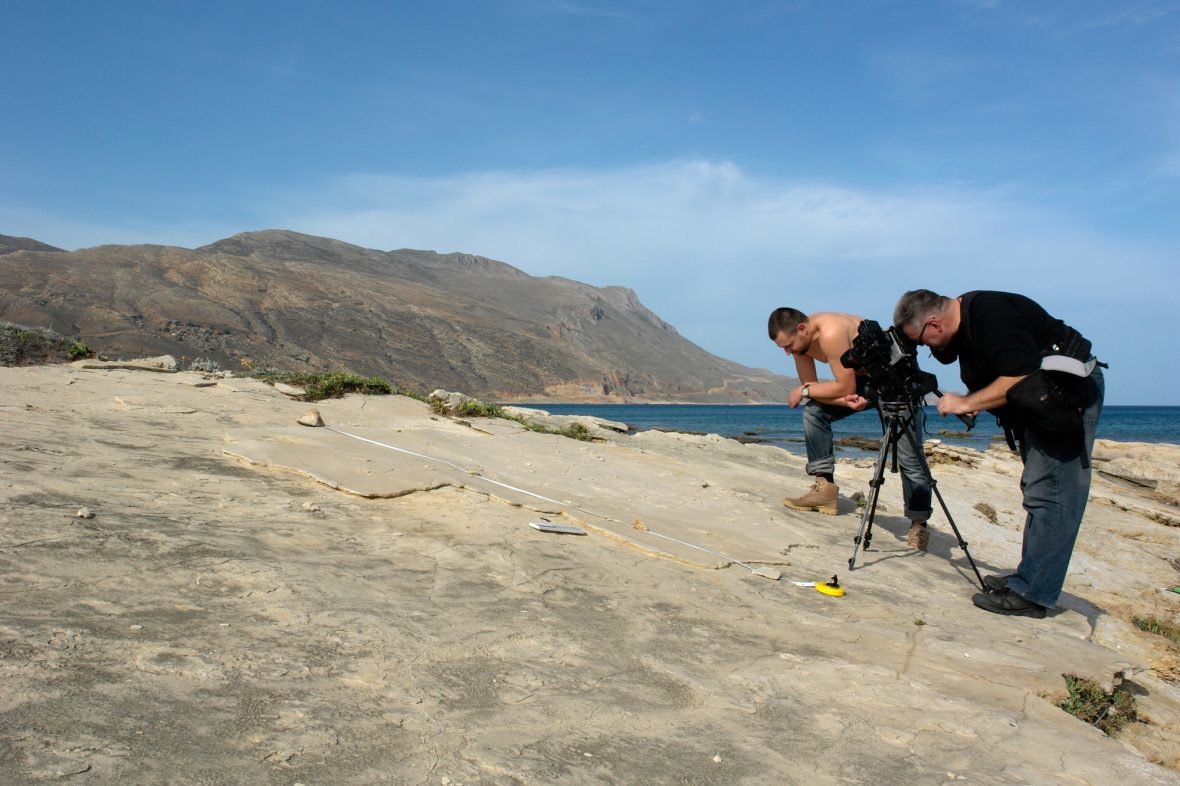
After six and a half years of responding to critical reviews, taking more measurements, doing more analysis, rewriting the manuscript and resubmitting it to different editors and reviewers, the research was made public. The paper finally made it through peer review and was published on Aug. 31, 2017, with the cautious title, "Possible hominin footprints from the late Miocene (c. 5.7 Ma) of Crete?"
The researchers readied themselves for the response.
IV. Biases and interests
The paper's publication caused a bit of a buzz in the mainstream media. A story in New Scientist carried the headline "Controversial footprints suggest we evolved in Europe not Africa," while UPI published a piece titled "Ancient footprints complicate story of human evolution." Ahlberg and Bennett also wrote an article on it in The Conversation - which runs stories by academic researchers for the general public - that got picked up by Newsweek and The Business Standard, among others.
Ahlberg said that since the paper was published, very few scientists have disputed that the marks are footprints, and "most have been cautiously positive about our interpretation."
"They are certainly convincing as real footprints," wrote Robin Crompton and Susannah Thorpe, both British hominin and great ape foot anatomy researchers, in The Conversation. However, they also noted "they could as well be those of gorillas - which separated from us over 10 million years ago - as those of a member of our own human lineage."
Not everyone in the scientific community is willing to entertain that idea. Lars Werdelin, a professor of paleontology at the Museum of Natural History in Stockholm, told Swedish news site SVT Nyheter that he wasn't sure the marks were really footprints.
Some of the harshest public criticism the paper has faced since it was published has been from Zachary Throckmorton, a foot anatomy researcher based at the Arkansas College of Osteopathic Medicine, who was part of the team that made the 2015 discovery of the human relative Homo naledi.
On Twitter, Throckmorton called the prints "dubious" and accused them of being "cherry-picked" from a poor sample.
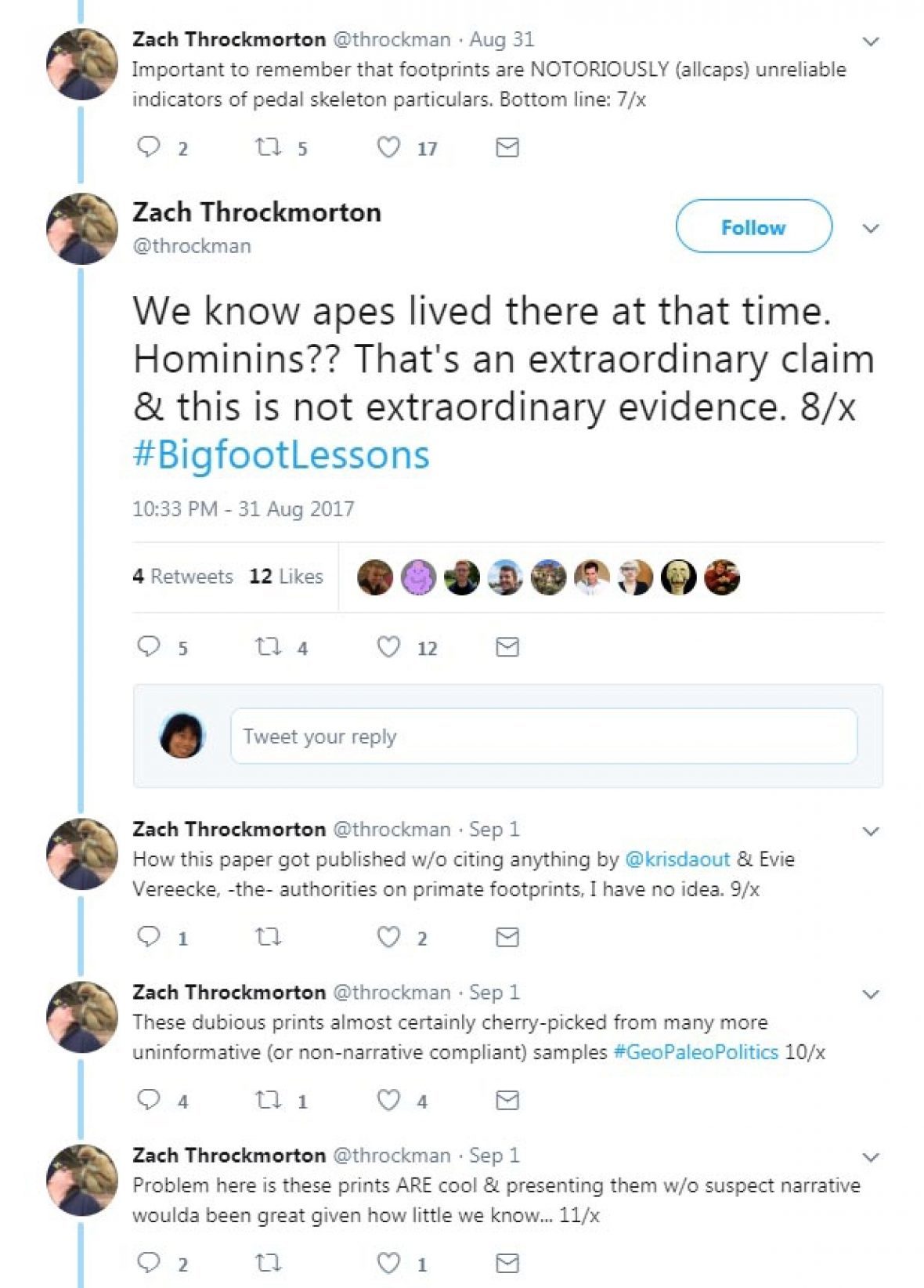
Throckmorton, who admitted he's not an expert in footprints, said those found in Trachilos are "pretty ambiguous" and could belong to an ape or a bear.
In response to one defence from Ahlberg - who was accidentally using his wife Jan's account at the time - Throckmorton said, "I doubt I'd say anything the reviewers that rejected this paper from other journals didn't already tell you."
Throckmorton told CBC he regretted being "a little snarky" with that comment. He said he found it "unusual" that the paper was published in a "fairly obscure" journal, one that dealt with geology. When CBC noted that the researchers had a lot of trouble getting published and asked Throckmorton what that says about science, he responded, "It's important to recognize that there are a lot of people involved in research like this and that many people have their own biases and they have their own interests.... But the strength of science is that eventually, enough people consider evidence ... and from that process of continued criticism, eventually the truth emerges."
It's possible that the reason Gierlinski, Ahlberg and their team had trouble getting published is because their research was just not as good or interesting as they thought. But since the paper has come out, Ahlberg said most critics have been relatively muted. Many who have seen the research have been publicly open to the possibility that these belong to a pre-human.
One thing Throckmorton, Crompton, Thorpe and other scientists have pointed out is that Gierlinski and Ahlberg haven't released their data - i.e. the laser scans of the footprints - for verification. Ahlberg said the plan is to do so after a more thorough analysis. "We are not greatly inclined just now to hand over all our data to the rest of the community so that people - including perhaps the very ones who tried to stop us from publishing - interpret it for us. You know?"
That's not the kind of criticism that bothers Ahlberg. What makes him bristle are Throckmorton's Twitter comments that extraordinary claims require extraordinary evidence - which he's heard too many times since trying to publish his paper.
Ahlberg said the study only appears extraordinary "if you have already decided that humans originated in Africa, and that humans were restricted to Africa for millions of years."
But is that not the case?
V. Buried stories?
The Smithsonian National Museum of Natural History neatly summarizes the most commonly accepted story of how humans evolved. Based on fossil evidence found exclusively in Africa, early hominins evolved in that continent between six and two million years ago. They likely migrated out of Africa into Asia between two million and 1.8 million years ago, and didn't set foot in Europe until between 1.5 million and one million years ago.
And that's the story that most human anthropology researchers are sticking to.
David Begun, a paleoanthropologist at the University of Toronto, said the people with the most influence on the major journals are committed Africanists.
"They simply cannot see the possibility that any important event in ape and human evolution could have occurred outside Africa until the first Homo left that continent about 2 million years ago," he wrote in an email. He said there's "no earthly reason why there could not have been (pre)humans on Crete 6 million years ago."
Many other mammals made the trek back and forth between the eastern Mediterranean and Africa numerous times, he said.
Begun was the co-author of a paper that analyzed the jawbone and molar of an ape called Graecopithecus freybergi that lived 7.2 million years ago in Europe, including in southern Greece. That study was also somewhat controversial, because Graecopithecus had human-like rather than ape-like tooth roots, suggesting that the ancestors of humans and great apes may have diverged in Europe rather than in Africa.

That problem isn't unique to this branch of science. Dr. Eleftherios Diamandis, professor and head of clinical biochemistry at U of T, has been an outspoken critic of the current scientific peer review process.
"Most of us have experienced numerous examples of poor peer review," he wrote in an opinion piece in the journal Clinical Biochemistry in 2017.
Diamandis said a fantastic paper can be rejected by reviewers for many different reasons. "They may be jealous, they may not like your writing style, they may not even like you, they're in a bad mood, whatever the human behaviour is," he said. "But actually, the major reason for people rejecting papers is some of these papers - and there is a whole history of it - are papers ahead of their time."
Whether that's true or not, Ahlberg said his experience has shaken his confidence in the process of science.
"The thing that really troubles me is the sense that we won here only through extreme persistence," he said. "It really does rather make you wonder what other sort of stories have been buried and have never come out."
Gierlinski said it was important to him to have the scientific community check over his work to ensure he hadn't made a mistake. But now that his research has been validated by peer review and official publication, he said, "I will be fighting to prove that I am right... because I am sure 100 per cent."
In the meantime, there's evidence the wider public has bought into the significance of the footprints - which is both a blessing and a curse for the prints themselves.
VI. Lost and found
Shortly after the research was published, four or five of the 29 prints were chiselled out of the rock in Trachilos and stolen. Fortunately, local authorities soon arrested a 55-year-old high school teacher from the area, and the damaged footprints were recovered, according to Greek news site Themanews.
No scientific data was lost, since the prints had already been laser-scanned in 3D. But Matthew Bennett told CBC Radio's Quirks & Quarks that what has been lost is the ability to "get that emotional connection with one's ancestor, to touch those footprints... It's not as bad as it could have been, but it's still very, very sad to see."
The footprints have since been buried under gravel and rocks on the beach in Trachilos, for their protection, and will remain so until spring.
Gierlinski said local authorities are now debating whether to remove the entire slab of footprints and relocate it to the local museum or build a protective structure so it can be viewed on the beach at the very place where it was found - his preferred option. He has also looked into options for removing graffiti that has been sprayed on the surface.
In the meantime, science will have to wait for more discoveries to be made in order to understand the truth behind the footprints found in Crete.
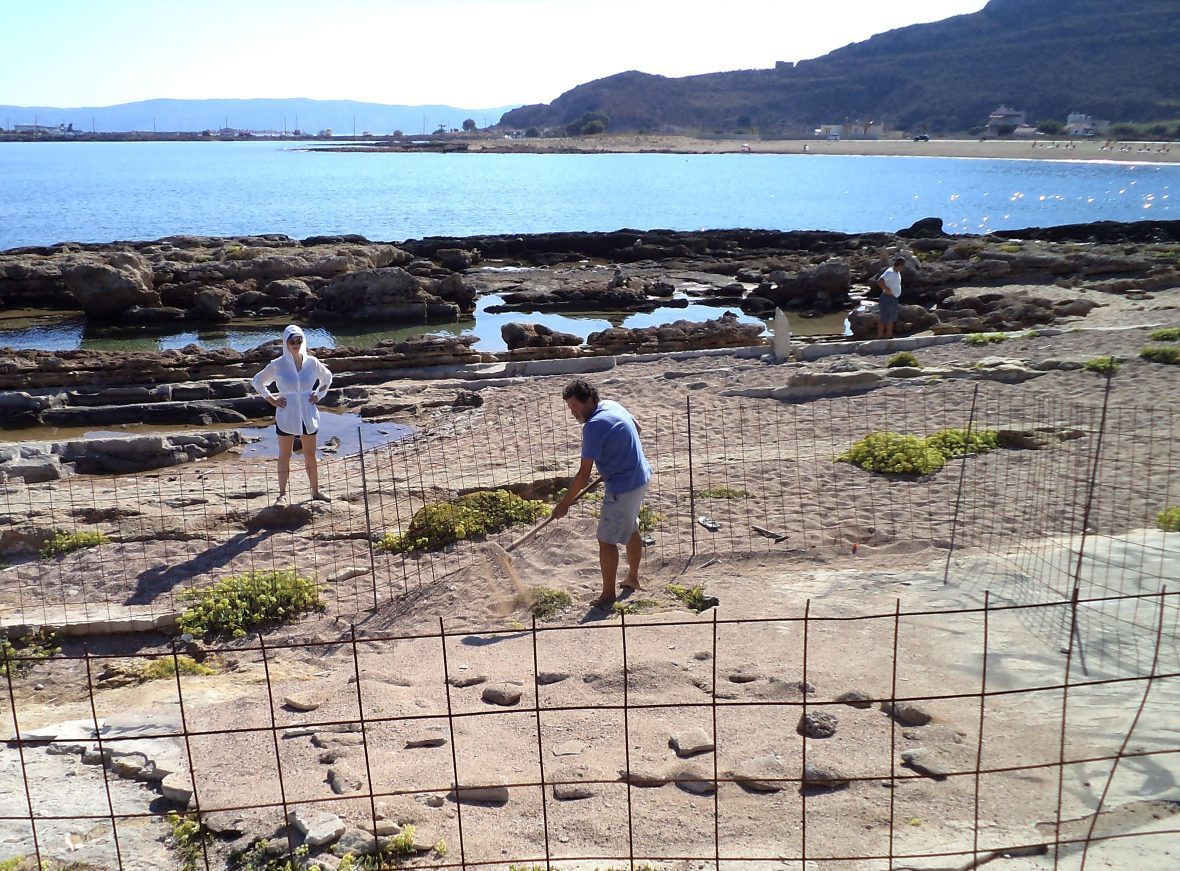
Lutz was publicly criticized by New Mexico State University anthropologist Monte McCrossin, who suggested the teeth were a deer molar and the tooth of a primitive primate called a pliopithecid. Lutz said he was taking the criticism seriously and would look into it. He declined to comment to CBC on either the research or why he chose to share it publicly before it had been peer-reviewed.
But Gierlinski told CBC in January that he has also recently found more footprints on Crete and that it is "very possible that we have another hominid."
He noted that footprints are preserved in very different conditions than fossils, so they can be found in places where fossils are impossible to find. He predicted that now that people know to look for them, there is a good chance that more will be found in Europe, the Middle East and North Africa. And that the longstanding narrative about human evolution may itself evolve rather dramatically.
In the meantime, we humans will have to wait to learn more about our ancestors. But the beauty of science is that in time, it does bring us closer to the truth.
"If you have something that is gold, sooner or later someone will realize," said U of T's Diamandis. "If you have something that is garbage ... you will get caught."
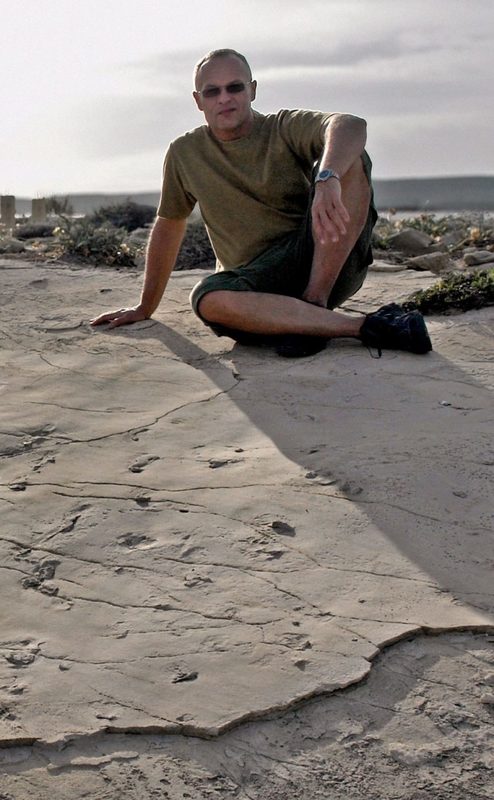
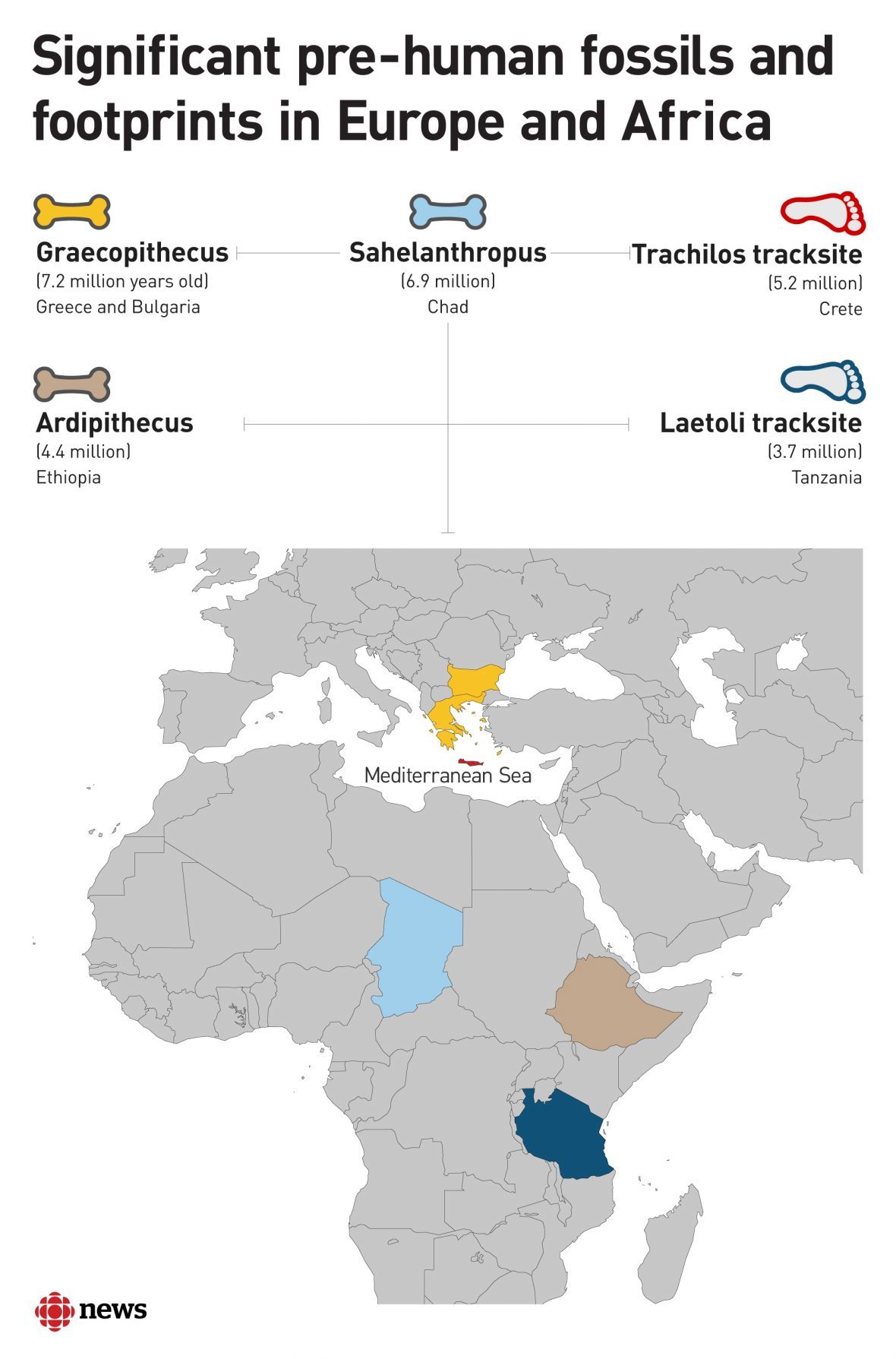



Reader Comments
Modern academia, due to exceptionalism caused by religion or the fact they won't change established theories in fear of loss of funds and credibility, will refuse all new evidence as coincidence, natural formations or pseudoscience.
The oldest fossil of man was discovered in Kenya by the Leakeys. That fossil was dated 18,000,000 years old.
The second oldest fossil was discovered in the Congo by the same people, and dated 14,000,000 years old.
Some of us had rathr brief spells of arithmetic partipation, but, simple arithmetc dictates that 18,000,000 is more than 14,000,000, which is more than 5, 200,000. The last time someone attempted this 'wonderful' heap of bullshit, they claimed 7.3 nillion years ago. Amazing.
Regardless of all the bullcrap they claim and write, the first people created were Ethiopians, in Ethiopia/Atlantis.
I urge you, please visit mycvp.com, and read the book - Ethiopia is Atlantis! Proven. Learn some shocking historical facts, as were used and referenced in the proof.
Beyond that, I encourage everyone to attempt to prove the book wrong.
Shalom '
No one can prove your book wrong as it is full of "your story". It is like me asking you to disprove "my story". If this is the story of your Ethiopian heritage and culture, great, but stop requesting something that knowingly cannot be done just to maintain the high ground.
Somehow, you show Giorgio Tsoukalos to be more accurate in ancient claims.
And there you go - proving to the world that you are simply another one who has been sleeping with your mouth too close your anus.
When you have sufficiently learned, we can engage, both qualitatively and quantitatively, your choice.
Till then, please remember this. i will only say it once.
It is better to keep your mouth close, and let people assume you are stupid. Than to open it, and remove all doubt.
Shalom
Nightfall can be considered a part of my book. For starting with you, it has begun bringing out the insects and rodents.
Shalom
I defy anyone to read two pages of this wishful thinking American-as-Hostess-Twinkies garbage without coming to the conclusion that George L is a dumb ass sentimentalist brown skinned would-be-Nazi snowball in Hell.
Your ancestors have never heard of you, George. They wouldn't like you if they met you.